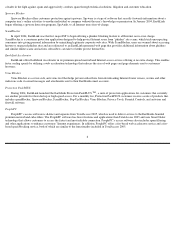Earthlink 2004 Annual Report Download - page 16
Download and view the complete annual report
Please find page 16 of the 2004 Earthlink annual report below. You can navigate through the pages in the report by either clicking on the pages listed below, or by using the keyword search tool below to find specific information within the annual report.
Our service offerings may fail to be competitive with existing and new competitors.
We operate in the Internet services market, which is extremely competitive. Current and prospective competitors include many large
companies that have substantially greater market presence, financial, technical, marketing and other resources than we have. We compete
directly or indirectly with the following categories of companies:
•
established online services companies, such as Time Warner (AOL) and the Microsoft Network (MSN);
•
local and regional ISPs;
•
free or value-priced ISPs such as United Online;
•
national telecommunications companies, such as AT&T and MCI;
•
regional Bell operating companies, such as SBC, Verizon and BellSouth;
•
content companies, such as Yahoo!, who have expanded their service offerings;
•
cable television companies providing broadband access, including Comcast, Charter and Cox Communications, Inc.; and
•
utility and local and long distance telephone companies.
Competition is likely to continue increasing, particularly as large diversified telecommunications and media companies continue to provide ISP
services. Diversified competitors may continue to bundle other content, services and products with Internet access services, potentially placing
us at a significant competitive disadvantage.
Because we operate in a highly competitive environment , the number of subscribers we are able to add may decline, the cost of acquiring
new subscribers through our own sales and marketing efforts may increase, and/or the number of subscribers who discontinue the use of our
service (churn) may increase. Increased churn rates indicate customers are discontinuing services which results in a decrease in our customer
base and adversely impacts revenues.
We continue to implement plans to address churn, including adding new features to enhance our service offerings. However, we can
provide no assurance that our plans will be successful in mitigating the adverse impact increased churn may have on our subscriber base and
operating results. In addition, competitive factors outside of our control may also adversely affect future rates of customer churn. If we
experience an increase in monthly churn rates, or if we are unable to attract new subscribers in numbers sufficient to increase or maintain the
level of our overall subscriber base, our business, financial position, results of operations and cash flows could be adversely affected.
As competition in the ISP market continues to intensify, competitors may merge or form strategic alliances that would increase their
ability to compete with us for subscribers. These relationships may negatively impact our ability to form or maintain our own strategic
relationships and could adversely affect our ability to expand our customer base.
Competitive product, price or marketing pressures could cause us to lose existing customers to competitors, or may cause us to reduce
prices for our services which could adversely impact our average revenue per user.
Competition impacts our ability to retain customers and price our services. As the market for Internet access remains competitive, some
providers have reduced and may continue to reduce the retail price of their Internet services to maintain or increase their market share, causing
us to reduce, or preventing us from raising, our prices and potentially causing our subscriber base to decrease. As a result, our revenues may
not grow at anticipated rates, and our business may suffer. Additionally, we may incur increased sales
13
























